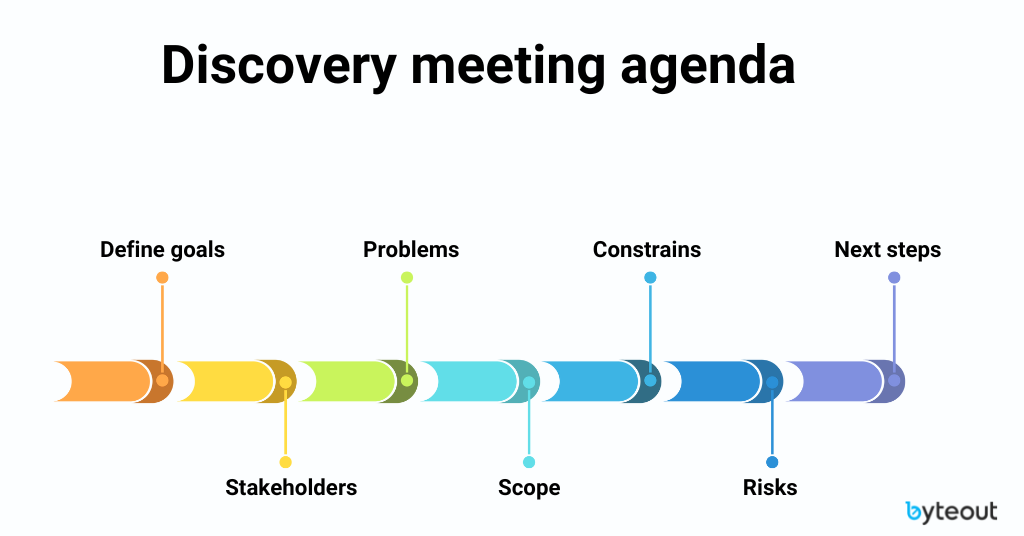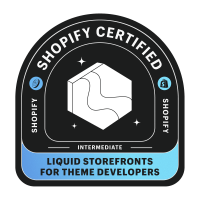In this step-by-step guide for handling a discovery meeting for e-commerce projects, we will explain how to properly structure the first meeting between the client and the development partner.
The discovery session is more like a consultation. You will go through your ideas, needs, and expectations of the project. But you will also cover mutual expectations in terms of collaboration.
What is a discovery meeting for e-commerce projects #
A software development discovery session is an important first step in any new software development project. It is a meeting between the development team and the client, where they work together to define the project’s goals, objectives, and requirements. A discovery meeting is crucial because it sets the tone for the rest of the project and ensures that everyone is on the same page. That is why discovery meeting should be the first step after the client and development partner sign the contract.
The discovery session is in the form of a meeting, and it usually lasts about 30 to 60 minutes. Also, it should be free of charge since it is an equal investment from both sides.
Discovery meeting preparation #
Ask the client to share all the materials about the project they might have before the discovery meeting.
Create a summary of your understanding of the project beforehand. Also make notes of all the unknowns or risks you see and share it with the client later. That way the meeting preparation will be more efficient and the discovery meeting will be more productive.
Discovery meeting agenda and steps #
As for any other meeting, there should be an agenda for the discovery meeting. This way, you will remember to cover the most important topics. Here are the steps that you need to go through during the discovery session.
- Define the goals of the session: Before the session begins, it’s essential to define the goals of the meeting. This will ensure that everyone is on the same page and that the session stays focused. The goals should include the expected outcomes of the session, the timeline for the project, and any specific deliverables.
- Identify stakeholders: The next step is to identify all the stakeholders involved in the project. This includes the development team, the client, and any other parties that will be involved in the project. It’s essential to have everyone in the same room for the session to ensure that everyone has a voice and can contribute to the discussion.
- Discuss the problem: The next step is to discuss the problem that the software development project aims to solve. This will give everyone a clear understanding of the project’s purpose and help them focus on finding a solution that meets the client’s needs.
- Define the scope: Once the problem has been identified, it’s time to define the scope of the project. This includes the features, functionality, and requirements that will be included in the final product. It’s essential to define the scope carefully to ensure that everyone is on the same page and that the project stays on track.
- Discuss constraints: It’s important to discuss any constraints that might impact the project. This includes things like budget, timeline, technology limitations, and any other factors that might impact the project’s success. By identifying these constraints early on, the development team can work to find solutions that meet the client’s needs while still staying within the project’s constraints.
- Identify risks: Another important step is to identify any risks that might impact the project’s success. This includes things like technical risks, market risks, and operational risks. By identifying these risks early on, the development team can work to mitigate them and ensure that the project stays on track.
- Determine next steps: Once the discovery session is complete, it’s essential to determine the next steps for the project. This includes defining the project plan, identifying roles and responsibilities, and setting up a timeline for the project. It’s important to ensure that everyone is clear on the next steps to ensure that the project stays on track.

Discovery meeting questions #
Questions you need to have answered after the discovery meeting are as follow. Make sure you ask all of them and have them written down in your discovery meeting output and share it with the client as a summary.
- What is the purpose of the project? – This question helps to define the overall goal of the project and what the client wants to achieve.
- Who are the end-users of the software? – Understanding the end-users helps to design the software with their needs and preferences in mind.
- What is the scope of the project? – This question helps to define the project’s boundaries and what features and functionalities will be included in the final product. And also what will not be included in the scope.
- What are the requirements of the project? – This question helps to identify the features and functionalities required for the software to meet the client’s needs.
- What are the technical requirements of the project? – This question helps to identify any technical specifications that must be met to develop the software successfully.
- What is the timeline for the project? – This question helps to establish a clear timeline for the project and ensure that everyone involved understands the expected completion date.
- What is the budget for the project? – This question helps to determine the project’s financial constraints and ensures that the development team stays within the budget.
- Who is responsible for what tasks? – This question helps to identify the roles and responsibilities of the development team and the client and ensure that everyone is clear about their tasks.
- What are the potential risks or obstacles? – This question helps to identify any potential risks or obstacles that may arise during the project and develop a plan to mitigate them.
- How will progress and success be measured? – This question helps to define the key performance indicators (KPIs) that will be used to measure progress and success during the project.
How to conclude the discovery meeting #
The conclusion of the discovery meeting is just as important as the session itself. It’s essential to ensure that everyone is on the same page and has a clear understanding of the project’s scope, goals, and objectives. Here are some steps to follow to conclude the discovery session effectively:
- Recap the meeting: Before concluding the meeting, it’s helpful to recap the discussion to ensure that everyone is on the same page. Summarize the key points and decisions that were made during the meeting.
- Identify next steps: Once everyone is clear on the project’s goals and objectives, identify the next steps that need to be taken.
- Establish communication protocols: It’s crucial to establish clear communication protocols during the discovery session. This includes determining how communication will take place, who will be responsible for communication, and how often communication will occur.
- Set expectations: Setting expectations is critical to the success of the project. Establish expectations for the development team and the client, including what is expected from each party and how progress and success will be measured.
- Follow up: After the discovery session, follow up with everyone involved to ensure that the project is on track. Schedule regular meetings to discuss progress and address any issues or concerns that arise.
By following these steps, you can conclude the discovery session effectively and ensure that everyone is clear on the project’s goals, objectives, and requirements. This helps to set the stage for a successful software development project that meets the client’s needs and expectations.
Summary for discovery meeting for e-commerce projects #
A software development discovery meeting is a critical first step in the development process, allowing the development team and client to understand the project’s goals, objectives, and requirements. The most important questions to ask during a discovery session include identifying the purpose and scope of the project, the end-users of the software, technical requirements, budget, and potential risks or obstacles.
To conclude a discovery session effectively, it’s essential to recap the discussion, identify next steps, establish communication protocols, set expectations, and follow up regularly to ensure the project is on track. Conducting a discovery session is essential to ensure that the final product meets the client’s needs and expectations while staying within budget and on schedule during the entire cycle of building the e-commerce project.
And never fail to follow up and meet the customer

